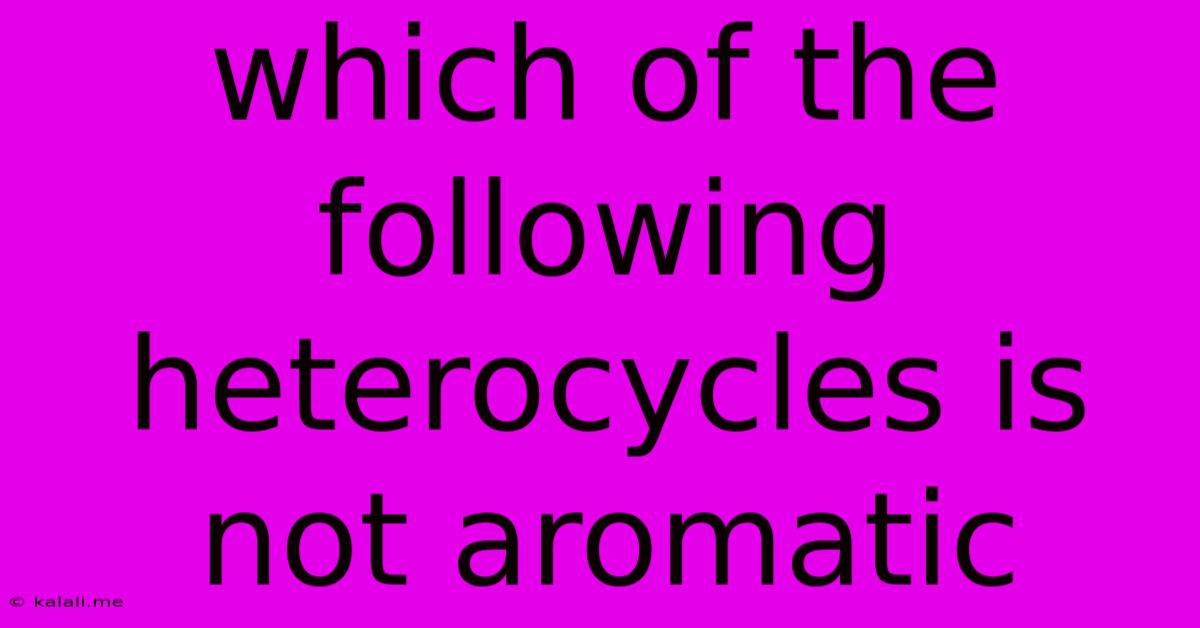Which Of The Following Heterocycles Is Not Aromatic
Kalali
Jun 15, 2025 · 3 min read

Table of Contents
Which of the following heterocycles is not aromatic? Understanding Aromaticity in Heterocycles
Aromatic heterocycles are a crucial class of compounds in organic chemistry, found everywhere from pharmaceuticals to natural products. Understanding their aromaticity is key to predicting their reactivity and properties. This article will explore the criteria for aromaticity and determine which of several common heterocycles fails to meet these requirements. We'll delve into Huckel's rule and examine structural features that impact aromaticity.
What makes a molecule aromatic?
A molecule is considered aromatic if it satisfies all four of Huckel's rules:
- Cyclic: The molecule must be a closed ring.
- Planar: All atoms in the ring must lie in the same plane. This allows for continuous overlap of p-orbitals.
- Conjugated: The molecule must have a continuous system of overlapping p-orbitals. This means alternating single and double bonds, or lone pairs that can participate in conjugation.
- Hückel's 4n+2 Rule: The molecule must have (4n + 2) π electrons, where n is an integer (0, 1, 2, 3...). This is crucial for stability.
Examples of Aromatic Heterocycles
Many common heterocycles are aromatic, including:
- Pyridine: A six-membered ring containing one nitrogen atom. The nitrogen atom contributes one electron to the π system, fulfilling the 4n+2 rule (6 π electrons).
- Pyrrole: A five-membered ring containing one nitrogen atom. The nitrogen atom's lone pair participates in the conjugated π system, contributing two electrons, resulting in 6 π electrons.
- Furan: A five-membered ring containing one oxygen atom. The oxygen atom contributes two electrons from a lone pair to the conjugated π system, again resulting in 6 π electrons.
- Thiophene: Similar to furan, thiophene is a five-membered ring with a sulfur atom. The sulfur atom contributes two electrons from a lone pair, leading to 6 π electrons.
Non-Aromatic Heterocycles
Now, let's consider some examples that aren't aromatic. A molecule might fail to meet one or more of Huckel's rules. For instance:
- Tetrahydrofuran (THF): This is a saturated five-membered ring containing an oxygen atom. It lacks the conjugated π system necessary for aromaticity. It's considered aliphatic, not aromatic.
- 1,3-Dioxole: This heterocycle does not meet Huckel's 4n+2 rule, containing only four π electrons. While cyclic and possessing conjugated π-bonds, the lack of proper electron count prevents it from being aromatic.
Determining Aromaticity: A Case Study
To illustrate, let's compare two molecules: Pyridine and Piperidine. Pyridine is aromatic because it is cyclic, planar, conjugated, and has 6 π electrons (4n+2 where n=1). Piperidine, however, is a saturated ring; the nitrogen lone pair is not involved in conjugation. It fails to meet the criteria of conjugation, making it non-aromatic.
Conclusion
The aromaticity of a heterocycle depends critically on its structure and the participation of heteroatoms in the conjugated π system. Understanding Huckel's rule and carefully evaluating each criterion is essential for classifying heterocyclic compounds. Remember, non-aromatic heterocycles exhibit very different chemical behavior compared to their aromatic counterparts. This distinction is fundamentally important in organic synthesis and drug design.
Latest Posts
Latest Posts
-
The Atomic Mass Number Is Equal To
Jun 15, 2025
-
Polar Moment Of Inertia Of Square
Jun 15, 2025
-
Which Of The Following Represents A Quantitative Research Design
Jun 15, 2025
-
Which Of The Following Is Not A Fundamental Quantity
Jun 15, 2025
-
Which Of The Following Is Not A Dimension Of Quality
Jun 15, 2025
Related Post
Thank you for visiting our website which covers about Which Of The Following Heterocycles Is Not Aromatic . We hope the information provided has been useful to you. Feel free to contact us if you have any questions or need further assistance. See you next time and don't miss to bookmark.